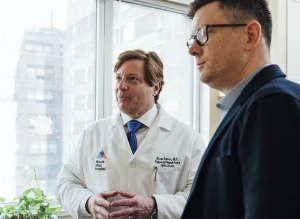Living with Castleman Disease
Published 16 Jul 2020 • By Pauline Heyries
Castleman disease is a rare condition that affects the lymph nodes, which in turn affects patients' immune systems. While the exact number of cases of Castleman disease is unknown, it is estimated that there are between 4,300 and 5,100 new cases per year in the United States.
It is important to remember that there are different forms of CD with different manifestations. If you wish, you can find more detailed information in the article “Castleman Disease: Everything you need to know!”.
What are the symptoms that can impact patients' quality of life? What are the side-effects of treatment and the constraints of the care pathway? What are the solutions to improve patient care and quality of life?

What are the symptoms that can impact patients' quality of life?
Castleman disease results in a variety of symptoms that can be hard on patients. These symptoms can have an impact on their social and professional life. Intense fatigue, nausea, night sweats, and chronic pain can make daily life difficult for patients. Some treatments can relieve their nausea and chronic pain, but they must learn to live with latent fatigue. It is important for those around you to understand that there is a difference between fatigue in a healthy person and a person with CD.
In the majority of cases, stomach upsets accompanied by pain, vomiting and nausea are observed, which generally leads to loss of appetite and weight loss. This is why it is very important to eat healthily. Here are a few tips:
- Eat regularly throughout the day, in small quantities and at room temperature (hot food may increase pain).
- Favour foods that are easy to chew and digest (yoghurt, apples, rice, lean meat, etc.).
- Avoid meals that are too fatty, sweet or spicy.
- Drink frequently, but in small quantities.
- Take a treatment for nausea, 30 minutes before meals if it is compatible with your current treatment. Ask your doctor or pharmacist for advice.
- Eat plain water biscuits when you wake up to limit nausea.
If you have a localised form of Castleman disease, you will in most cases be asymptomatic, but if symptoms appear, contact your doctor immediately.
Here are the things you should watch for:
- Lymph node enlargement (depending their size, this may be observed with the naked eye, otherwise a simple palpation can help with identification)
- Fever
- Night sweats
- Loss of appetite and weight loss
- Weakness and fatigue
- Shortness of breath
- Nausea and vomiting
- Skin rashes
What are the side effects of treatment and the constraints of the care pathway?
Patients' treatment depends on the type of Castleman disease.
If the patient has unicentric CD, surgical removal of the lymph node or lymph node area is the recommended approach. There are risks associated with this approach depending on the vascularity of the lesion. If the lymph node is highly vascularized, intra- or postoperative bleeding should be monitored. However, the results are excellent: symptoms usually disappear after surgery and recurrence is rare. It is important to follow your surgeon's advice before and after the procedure.
After surgery, the area around the lymph node is likely to be painful and tender as it heals. You may want to ask your doctor to prescribe an analgesic help you manage the pain. It is important to let the affected limb or joint rest as much as possible for several days. Avoid activities such as typing or cooking for a time. In addition, don't hesitate to ask your doctor for a recovery plan that includes the following:
- An estimate of the necessary healing time
- Activities you should avoid, especially during your recovery
- Symptoms you need to watch for that may indicate a problem after the procedure
If the patient has multicentric CD and requires radiotherapy, there are significant risks, especially in younger patients. Factors to be taken into account for the patient to adapt his or her treatment are:
- Vascularity of the lesion
- A cardiac abnormality
- A localized pulmonary abnormality
- Thyroid damage
The risks of taking corticosteroids are known, but it is important to make sure that the patient does not develop psychological disorders (mood swings, memory, thinking or behavioural problems), high blood pressure, increased blood sugar levels, brittle bones, muscular weakness and water retention if taken for long periods of time.
For some severe cases of CD, chemotherapy may be considered. Chemotherapy can cause many side effects, such as hair loss, mouth sores, nausea, vomiting, diarrhoea, infection, fatigue and weakness. It is an aggressive treatment that can make patients susceptible to bruising or bleeding.
What solutions can be considered to improve patient care and quality of life?
For optimal care, it is necessary to create a relationship of trust with your doctor. Castleman disease is rare and difficult to diagnose, so it is important that your doctor be a specialist in the disease. Most often you will be treated by haematologists, experts in both blood and immune system diseases. The relationship that the patient has with his or her doctor is important in the healing process.
Make sure to prepare your questions before each consultation and ask your questions while with your doctor to create a climate of trust and gain a better understanding of your issues and concerns.
Here are a few examples of questions to ask your doctor:
- Have you ever treated this disease in the past?
- What kind of tests will I have to do?
- Has my biopsy been examined by a specialist experienced with Castleman disease?
- What subtype of Castleman disease do I have?
- What other diagnoses have you considered and ruled out?
- When should I start treatment?
- How long will treatment take?
- Will I need follow-up care after treatment?
Patients with a rare disease need support from their family and friends. It has been shown that a patient's psychological state has an impact on his or her recovery. As a loved one of a person with Castleman disease, listening is crucial. It is never easy to know what to do and how to support a patient, so here are some simple tips that can help:
- Be generally available. Let him or her know you're there. Show your presence with little gestures. Make sure to not repeatedly ask "How are you?", you will put the illness back at the centre of the conversation.
- Offer to go with the patient to medical appointments and perhaps be proactive in asking questions and taking notes (to help the patient, who may be in shock after receiving the news of the diagnosis).
- Send text messages, call regularly or send a postcard to get news (without necessarily waiting for a reply).
- Show empathy and support the patient's reaction to their illness (be it fear, anger, etc.).
- Help with daily chores (cleaning, shopping, childcare, etc.).
- Offer to be the link with friends (to simplify the sharing of news and updates on the patient's condition to friends and loved ones).
- Give a gift to improve well-being during recovery
The friend or family member is not always the best person to talk about the patient's illness. It may therefore be helpful to refer him or her, without abandoning them, to a patients' association, or to health professionals such as psychiatrists or psychologists. If the patient is apprehensive about consulting a psychologist, or about what might happen in a session, you can offer to show videos illustrating how psychotherapy sessions take place.
There are a number of support and research organisations out there for patients. These groups and organisations provide emotional support as well as information on new research and treatments. Although Castleman disease is rare, there are organisations like Carenity that can put you in touch with others who have the disease. In the United States there is an active community of researchers, families and patients called the Castleman Disease Collaborative Network (CDCN). They provide updates on recent research.
Data on Castleman disease is invaluable. There are a number of options available to patients to help improve their care. They can simply participate in surveys, just as you will have the opportunity to do on Carenity, in order to contribute to the advancement of medical knowledge. They can also give their consent to share their medical records in order to advance research more quickly. Castleman patients can give blood, saliva and lymph node samples as well.
It is also possible to join a clinical trial. Patient participation in research studies is extremely important to learn about the disease and the development of new treatments. The Castleman Disease Collaborative Network (CDCN) organises research trials on Castleman disease and can coordinate your participation in research projects:
- The U.S. National Institutes of Health maintains a database of clinical trials for developmental disorders that are currently active, under recruitment or completed.
- The CDCN maintains a database of people with Castleman disease to assist researchers.
For more information:
Feel free to visit the CDCN website (Castleman Disease Collaborative Network) website for more information.
Sources :
https://www.diseasemaps.org/fr/castleman-disease/top-questions/etre-heureux/
https://cdcn.org/castleman-disease/faq/
https://herpes.ooreka.fr/astuce/voir/624707/maladie-de-castleman#:~:text=Dans%20la%20maladie%20de%20Castleman%2C%20les%20ganglions%20et,perte%20d%27app%C3%A9tit%20qui%20peut%20amener%20%C3%A0%20un%20amaigrissement.
https://www.has-sante.fr/upload/docs/application/pdf/2019-11/pnds_castleman_2019.pdf
https://castleman.fr/registre-national/
https://comenr.com/59581-comment-traiter-la-maladie-de-castleman/
https://comenr.com/59581-comment-traiter-la-maladie-de-castleman/
https://health.freefrencharticles.com/index.php/2018/08/01/comment-traiter-la-maladie-de-castleman.html
http://www.pharmaciedelepoulle.com/Vomissements.htm#:~:text=1%20Prendre%20les%20anti-naus%C3%A9eux%2030%20minutes%20avant%20les,Les%20boissons%20gazeuses%20sont%20possibles%20More%20items...%20

 Facebook
Facebook Twitter
Twitter



